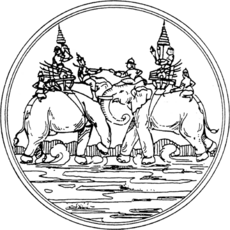Burmese–Siamese War (1568–1569)
| War of the first fall of Ayutthaya | |||||||
|---|---|---|---|---|---|---|---|
 War elephants depicted from a later Siam–Burma war. | |||||||
| |||||||
| Belligerents | |||||||
|
Lan Xang Kingdom |
| ||||||
| Commanders and leaders | |||||||
|
Setthathirath | |||||||
| Units involved | |||||||
|
Luzon Mercenaries[1] |
mercenaries | ||||||
| Strength | |||||||
| Unknown |
Burmese sources: Bayinnaung's five armies Invasion force: | ||||||
| Casualties and losses | |||||||
|
Siam Unknown Lan Xang 30,000 troops and 100 elephants | Unknown | ||||||
The Burmese–Siamese War (1568–1569) also known as the War of the first fall (สงครามคราวเสียกรุงครั้งที่หนึ่ง) was a military conflict fought between the Kingdom of Ayutthaya (Siam) and the Kingdom of Burma. The war began in 1568 when Ayutthaya unsuccessfully attacked Phitsanulok, a Burmese vassal state. The event was followed by a Burmese intervention which resulted in the 2 August 1569 defeat of Ayutthaya, which became a Burmese vassal state. Burma then moved towards Lan Xang, occupying the country for a short period of time until retreating in 1570.
Background
In 1485,
Internal struggles over the control of the
A second
Conflict
Prelude
In 1568, Ayutthaya king
Siege of Phitsanulok
A Burmese force broke through the Lao lines and joined the defenders of Phitsanulok which was besieged at the time. In the meantime, an Ayutthayan army advanced on Phitsanulok under the guise of reinforcements. Upon their arrival the Ayutthayans were asked to stay outside the city, on the same night the Phitsanulokans launched flaming rafts on the Ayutthayan fleet, destroying it. The losses prompted both the Lao and Ayutthayans to break the siege and retreat, the Lao troops later ambushed and annihilated a Burmese force that attempted to chase them.[11][12]
During the course of his retreat, Maha Chakkraphat unsuccessfully attacked Kamphaeng Phet. His plans changed however when he learned that Mahathammarachathirat was on an official visit to Burma, causing him to return to Phitsanulok. The Ayutthayans then proceeded to kidnap all of Mahathammarachathirat's family but his son Prince Naresuan who was accompanying his father. The kidnapping was to dissuade Phitsanulok from launching counter-attacks on Ayutthaya, nonetheless this act led the Burmese to initiate a joint invasion of Ayutthaya with the help of their Thai puppet states.[13]
Having gained the support of northern Thai states,
Siege of Ayutthaya and Vientiane
Siege of Ayutthaya
The Burmese then laid siege to Ayutthaya city. After heavy cannon fire put a stop to Burmese attempts at digging up to the walls, the invaders began building a bridge at Koh Keo in order to access the walls from a new direction. Maha Chakkraphat died during the course of the siege, therefore his son Mahinthrathirat ascended the throne. Frequent Ayutthaya sorties once again prevented the Burmese from finishing the construction. Bayinnaung then sent an Ayutthayan noble he held captive under the guise of a deserter. Not only was the spy allowed into the city but he was also put into a position of power. On the night of 7 August 1569, the spy opened the gates of the city, bringing its downfall. The Burmese army sacked the city. Mahinthrathirat along with his family and the nobility were captured and taken to Pegu. Mahinthrathirat died on the way in the same year.[15]: 63 Ayutthaya became a Burmese vassal state, with Mahathammarachathirat appointed king.[14][4][16]
Burmese invasion of Lan Xang
The Burmese took several weeks to regroup and rest having taken Ayutthaya, which allowed Lan Xang to rally their forces and plan for prolonged
Notes
- ^ Pires, Tomé (1944). Armando Cortesao (translator) (ed.). A suma oriental de Tomé Pires e o livro de Francisco Rodriguez: Leitura e notas de Armando Cortesão [1512 - 1515] (in Portuguese). Cambridge: Hakluyt Society.
- ^ a b Hmannan 2003, pp. 402–403.
- ^ Harvey 1925, p. 334.
- ^ a b c Pamaree Surakiat (2005). "Thai-Burmese Warfare During the Sixteenth Century and the Rise of the Toungoo Empire" (PDF). The Siam Society. Retrieved 12 June 2015.
- ^ Wood 1924, pp. 108–114.
- ^ Rajanubhab 2001, pp. 13–15.
- ^ Sein Lwin Lay 2006, p. 296.
- ^ Jumsai 1976, pp. 154–158.
- ^ Rajanubhab 2001, p. 67.
- ^ Rajanubhab 2001, p. 36.
- ^ Jumsai 1976, pp. 160–161.
- ^ Jumsai 1976, p. 164.
- ^ Jumsai 1976, pp. 165–166.
- ^ a b Jumsai 1976, pp. 166–171.
- ISBN 9747534584
- ^ a b Simms 1999, p. 79–81.
References
- Harvey, G. E. (1925). History of Burma: From the Earliest Times to 10 March 1824. London: Frank Cass & Co. Ltd.
- Royal Historical Commission of Burma (1832). Hmannan Yazawin (in Burmese). Vol. 2 (2003 ed.). Yangon: Ministry of Information, Myanmar.
- Jumsai, Manich (1976). "King Tilokarat (1441–1485)". Popular History of Thailand. Bangkok,Thailand: Claremint. ASIN B002DXA1MO.
- Rajanubhab, Damrong (2001). Our Wars With the Burmese. Bangkok,Thailand: White Lotus. ISBN 9747534584.
- Wood, William A. R. (1924). History of Siam. Thailand: Chalermit Press. ISBN 1-931541-10-8.
- Sein Lwin Lay, Kahtika U (2006) [1968]. Mintaya Shwe Hti and Bayinnaung: Ketumadi Taungoo Yazawin (in Burmese) (2nd printing ed.). Yangon: Yan Aung Sarpay.
- Simms, Peter and Sanda (1999). The Kingdoms of Laos: Six Hundred Years of History. Curzon Press. ISBN 0-7007-1531-2.
